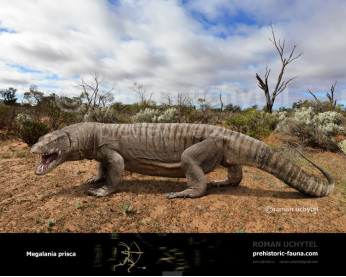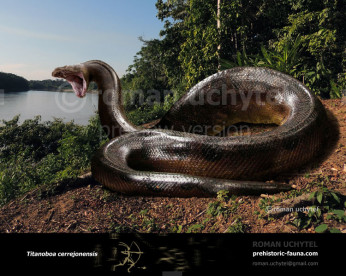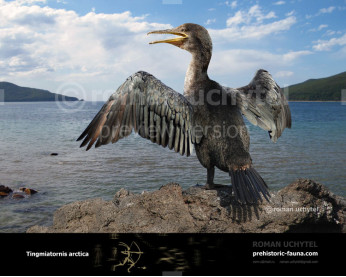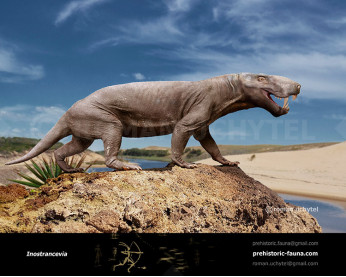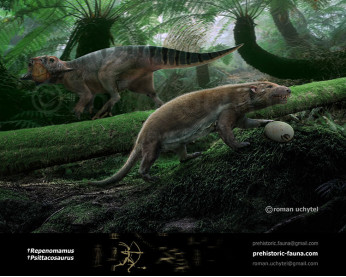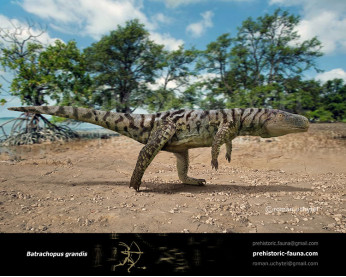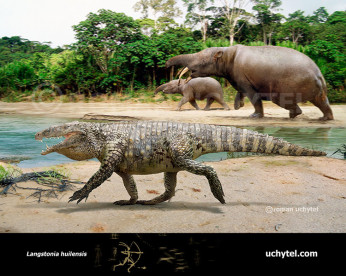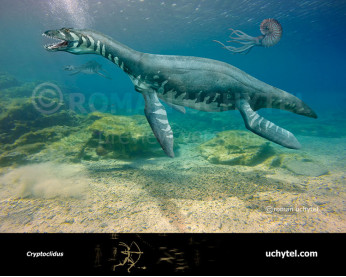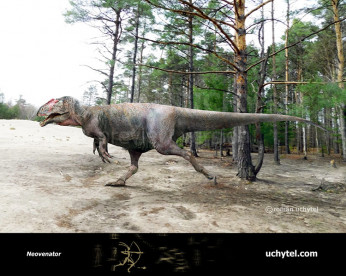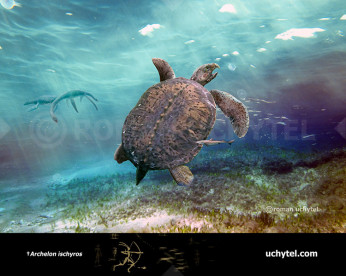Psittacosaurus
2029420294Psittacosaurus (†Psittacosaurus (Osborn, 1923))
Clade: Dinosauria
Clade: †Ornithischia
Clade: †Neornithischia
Clade: †Marginocephalia
Clade: †Ceratopsia
Family: †Psittacosauridae
Dimensions: up to 2 m length, weight - 15 -20 kg
Expansion: Early Cretaceous of Asia
Psittacosaurus is a genus of extinct ceratopsian dinosaur from the Early Cretaceous of what is now Asia, existing between 125 and 105 million years ago. It is notable for being the most species-rich non-avian dinosaur genus. Up to 12 species are known, from across China, Mongolia, Russia, and Thailand. The species of Psittacosaurus were obligate bipeds at adulthood, with a high skull and a robust beak. One individual was found preserved with long filaments on the tail, similar to those of Tianyulong. Psittacosaurus probably had complex behaviours, based on the proportions and relative size of the brain. It may have been active for short periods of time during the day and night, and had well-developed senses of smell and vision.
Psittacosaurus was one of the earliest ceratopsians, but closer to Triceratops than Yinlong. Once in its own family, Psittacosauridae, with other genera like Hongshanosaurus, it is now considered to be senior synonym of the latter and an early offshoot of the branch that led to more derived forms. The genera closely related to Psittacosaurus are all from Asia, with the exception of Aquilops, from North America.
The species of Psittacosaurus vary in size and specific features of the skull and skeleton, but share the same overall body shape. The best-known—P. mongoliensis—can reach 2 metres in length. The maximum adult body weight was most likely over 20 kilogrammes in P. mongoliensis. Several species approach P. mongoliensis in size (P. lujiatunensis, P. neimongoliensis, P. xinjiangensis), while others are somewhat smaller (P. sinensis, P. meileyingensis). The smallest known species, P. ordosensis, is 30% smaller than P. mongoliensis.The largest are P. lujiatunensis and P. sibiricus, although neither is significantly larger than P. mongoliensis. Psittacosaurus postcranial skeletons are more typical of a 'generic' bipedal ornithischian. There are only four digits on the manus ('hand'), as opposed to the five found in most other ornithischians (including all other ceratopsians), while the four-toed hindfoot is very similar to many other small ornithischians.
Psittacosaurs had self-sharpening teeth that would have been useful for cropping and slicing tough plant material. Unlike later ceratopsians, they did not have teeth suitable for grinding or chewing their food. Instead, they used gastroliths—stones swallowed to wear down food as it passed through the digestive system. Sometimes numbering more than fifty, these stones are occasionally found in the abdominal cavities of psittacosaurs, and may have been stored in a gizzard, as in modern birds.
Unlike many other dinosaurs, psittacosaurs had akinetic skulls: that is to say, the upper and lower jaws each behaved as a single unit, without internal joints. The only joint was the jaw joint itself, and psittacosaurs could slide their lower jaws forward and backward on the joint, permitting a shearing action. Unlike most ceratopsians, their beaks did not form curved tips, but were instead rounded and flattened. A nut- or seed-rich diet would also match well with the gastroliths often seen in well-preserved psittacosaur skeletons.
Psittacosaurus (†Psittacosaurus (Osborn, 1923))
Clade: Dinosauria
Clade: †Ornithischia
Clade: †Neornithischia
Clade: †Marginocephalia
Clade: †Ceratopsia
Family: †Psittacosauridae
Dimensions: up to 2 m length, weight - 15 -20 kg
Expansion: Early Cretaceous of Asia
Psittacosaurus is a genus of extinct ceratopsian dinosaur from the Early Cretaceous of what is now Asia, existing between 125 and 105 million years ago. It is notable for being the most species-rich non-avian dinosaur genus. Up to 12 species are known, from across China, Mongolia, Russia, and Thailand. The species of Psittacosaurus were obligate bipeds at adulthood, with a high skull and a robust beak. One individual was found preserved with long filaments on the tail, similar to those of Tianyulong. Psittacosaurus probably had complex behaviours, based on the proportions and relative size of the brain. It may have been active for short periods of time during the day and night, and had well-developed senses of smell and vision.
Psittacosaurus was one of the earliest ceratopsians, but closer to Triceratops than Yinlong. Once in its own family, Psittacosauridae, with other genera like Hongshanosaurus, it is now considered to be senior synonym of the latter and an early offshoot of the branch that led to more derived forms. The genera closely related to Psittacosaurus are all from Asia, with the exception of Aquilops, from North America.
The species of Psittacosaurus vary in size and specific features of the skull and skeleton, but share the same overall body shape. The best-known—P. mongoliensis—can reach 2 metres in length. The maximum adult body weight was most likely over 20 kilogrammes in P. mongoliensis. Several species approach P. mongoliensis in size (P. lujiatunensis, P. neimongoliensis, P. xinjiangensis), while others are somewhat smaller (P. sinensis, P. meileyingensis). The smallest known species, P. ordosensis, is 30% smaller than P. mongoliensis.The largest are P. lujiatunensis and P. sibiricus, although neither is significantly larger than P. mongoliensis. Psittacosaurus postcranial skeletons are more typical of a 'generic' bipedal ornithischian. There are only four digits on the manus ('hand'), as opposed to the five found in most other ornithischians (including all other ceratopsians), while the four-toed hindfoot is very similar to many other small ornithischians.
Psittacosaurs had self-sharpening teeth that would have been useful for cropping and slicing tough plant material. Unlike later ceratopsians, they did not have teeth suitable for grinding or chewing their food. Instead, they used gastroliths—stones swallowed to wear down food as it passed through the digestive system. Sometimes numbering more than fifty, these stones are occasionally found in the abdominal cavities of psittacosaurs, and may have been stored in a gizzard, as in modern birds.
Unlike many other dinosaurs, psittacosaurs had akinetic skulls: that is to say, the upper and lower jaws each behaved as a single unit, without internal joints. The only joint was the jaw joint itself, and psittacosaurs could slide their lower jaws forward and backward on the joint, permitting a shearing action. Unlike most ceratopsians, their beaks did not form curved tips, but were instead rounded and flattened. A nut- or seed-rich diet would also match well with the gastroliths often seen in well-preserved psittacosaur skeletons.

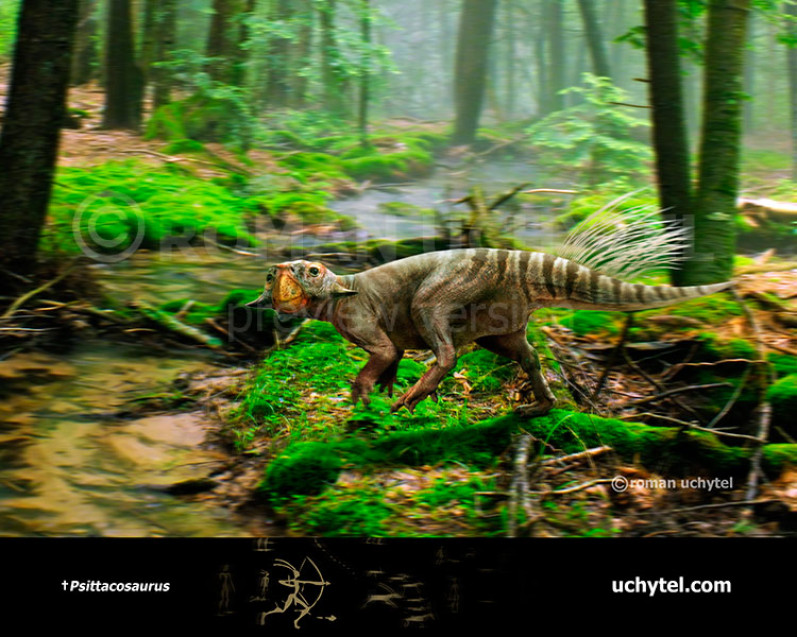
-797x638.jpg)

-70x56.jpg)
